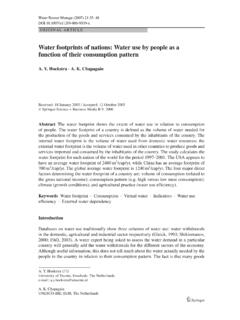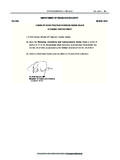Transcription of 1 page document - water footprint
1 The water footprint assessment manualHardback PPC: Live area 159 x 240mm Trim size 156 x 234mm Bleed 18mm Spine 1 page documentCover image: water Background BAYRAMW ater / Environmental and Sustainability assessment / Agriculture and FoodEarthscan strives to minimize its impact on the use a lot of water for drinking, cooking and washing, but significantly more for producing things such as food, paper and cotton clothes. The water footprint is an indicator of water use that looks at both direct and indirect water use of a consumer or producer. Indirect use refers to the virtual water embedded in tradable goods and commodities, such as cereals, sugar or cotton. The water footprint of an individual, community or business is defined as the total volume of fresh water that is used to produce the goods and services consumed by the individual or community or produced by the book offers a complete and up-to-date overview of the global standard on water footprint assessment as developed by the water footprint Network.
2 More specifically it:provides a comprehensive set of methods for water footprint assessmentshows how water footprints can be calculated for individual processes and products, as well as for consumers, nations and businessescontains detailed worked examples of how to calculate green, blue and grey water footprints describes how to assess the sustainability of the aggregated water footprint within a river basin or the water footprint of a specific productincludes an extensive library of possible measures that can contribute to water footprint Y. Hoekstra is Professor in water Management at the University of Twente, the Netherlands; creator of the water footprint concept and Scientific Director of the water footprint K. Chapagain was an irrigation engineer in Nepal for more than a decade, has worked as a researcher at the University of Twente and currently works for the WWF in the M. Aldaya works as a consultant for the United Nations Environment Programme (UNEP) and is a researcher at the water footprint M.
3 Mekonnen was an energy expert at the Ministry of Mines and Energy in Ethiopia, and is currently a PhD student at the University of water footprint assessment ManualSetting the Global StandardThe water footprint assessment ManualArjen Y. Hoekstra, Ashok K. Chapagain, Maite M. Aldaya and Mesfin M. MekonnenHoekstra, Chapagain, Aldaya and MekonnenThe water footprint assessment ManualThe water footprint assessment ManualSetting the Global StandardArjen Y. Hoekstra, Ashok K. Chapagain, Maite M. Aldaya and Mesfin M. MekonnenLondon Washington, DCp u b l i s h i n g f o r a s u s t a i n a b l e f u t u reFirst published in 2011 by EarthscanCopyright water footprint Network 2011 All rights reserved. No part of this publication may be reproduced, stored in a retrieval system, or transmitted, in any form or by any means, electronic, mechanical, photocopying, recording or otherwise, except as expressly permitted by law, without the prior, written permission of the publisher.
4 Earthscan Ltd, Dunstan House, 14a St Cross Street, London EC1N 8XA, UKEarthscan LLC,1616 P Street, NW, Washington, DC 20036, USAE arthscan publishes in association with the International Institute for Environment and DevelopmentFor more information on Earthscan publications, see or write to 978-1-84971-279-8 hardback Typeset by JS Typesetting Ltd, Porthcawl, Mid GlamorganCover design by Rob Watts; water footprint design by Angela MorelliA catalogue record for this book is available from the British LibraryLibrary of Congress Cataloging-in-Publication DataThe water footprint assessment manual : setting the global standard / Arjen Y. Hoekstra .. [et al.]. p. cm. Includes bibliographical references and index. ISBN 978-1-84971-279-8 (hardback)1. water consumption Measurement. 2. water consumption Environmental aspects. 3. water -supply Accounting. I. Hoekstra, Arjen Y., 1967 2011 13 dc22 2010047901At Earthscan we strive to minimize our environmental impacts and carbon footprint through reducing waste, recycling and offsetting our CO2 emissions, including those created through publication of this book.
5 For more details of our environmental policy, see and bound in the UK by TJ International Ltd, Padstow, paper used is FSC certified and the ink are vegetable of Figures, Tables and Boxes ixAcknowledgements xiiiPreface xviiAcronyms xix1 Introduction 1 Background 1 The water footprint concept 2 water footprint assessment 3 Guide for the reader 52 Goals and Scope of water footprint assessment 7 Goals of water footprint assessment 7 Scope of water footprint accounting 9 Scope of water footprint sustainability assessment 15 Scope of water footprint response formulation 163 water footprint Accounting 19 Human appropriation of fresh water : What do we measure and why? 19 Coherence between different sorts of water footprint accounts 21 water footprint of a process step 23 Blue water footprint 23 Green water footprint 29 Grey water footprint 30 Calculation of the green, blue and grey water footprint of growing a crop or tree 40 water footprint of a product 46 Definition 46 Schematization of the production system into process steps 47 Calculation of a product water footprint 48 water footprint of a consumer or group of consumers 52vi The water footprint assessment manual Definition 52 Calculation 52 water footprint within a geographically delineated area 53 Definition 53 Calculation 53 National water footprint accounting 54 The national water footprint accounting scheme 54 Calculation of the water footprint within a nation 55 Calculation of the water footprint of national consumption 56 water savings related to trade 60 National water dependency versus water self-sufficiency 61 water footprint accounting for catchments and river basins 61 water footprint accounting for municipalities.
6 Provinces or other administrative units 63 water footprint of a business 63 Definition 63 Choosing the organizational boundaries of the business 65 Calculation of the business water footprint 684 water footprint Sustainability assessment 73 Introduction 73 Geographic sustainability: Sustainability of the water footprint within a catchment or river basin 76 Introduction 76 Environmental sustainability criteria for identifying environmental hotspots 78 Social sustainability criteria for identifying social hotspots 87 Economic sustainability criteria for identifying economic hotspots 88 Assessing primary and secondary impacts in the hotspots identified 88 Sustainability of the water footprint of a process 89 Sustainability of the water footprint of a product 91 Identifying the unsustainable components in the water footprint of a product 91 water footprint impact indices reflecting local environmental impacts 94 Sustainability of the water footprint of a business 97 Sustainability of the water footprint of a consumer 97 Contents vii5 Library of water footprint Response Options 99 Shared responsibility 99 Reducing the water footprint
7 Of humanity: What is possible? 99 Consumers 103 Companies 106 Farmers 107 Investors 109 Governments 1106 Limitations 1157 Future Challenges 119 water footprint assessment methodology and data 119 Application of the water footprint in different contexts 122 Embedding the water footprint in existing water and environmental accounts and reports 123 Linking to ecological, energy and carbon footprint methods 124 Linking to material flow analysis, input-output modelling and life cycle assessment 1258 Conclusion 129 Appendix I Calculation of Green and Blue Evapotranspiration Using the CROPWAT Model 131 Appendix II Calculating the Process water footprint of Growing a Crop: An Example for Sugar Beet in Valladolid (Spain) 135 Appendix III Calculating the water footprint of a Product: Example for Refined Sugar from Valladolid (Spain) 143 Appendix IV Examples of Grey water footprint Calculations 147 Appendix V Environmental Flow Requirements 151 Appendix VI Frequently Asked Questions 155 References 169 List of Symbols 183 Glossary 187 Index 199 List of Figures, Tables and Schematic representation of the components of a water footprint .
8 It shows that the non-consumptive part of water withdrawals (the return flow) is not part of the water footprint . It also shows that, contrary to the measure of water withdrawal , the water footprint includes green and grey water and the indirect water -use component Four distinct phases in water footprint assessment The green and blue water footprint in relation to the water balance of a catchment area Process water footprints as the basic building block for all other water footprints The direct and indirect water footprint in each stage of the supply chain of an animal product The relation between the water footprint of national consumption and the water footprint within a nation in a simplified example for two trading nations Blue water footprint accounting in the case of water recycling and reuse The subsequent processes in irrigation: storing water , transport of water , irrigation on the field. Each process step has its own water footprint Schematization of the production system to produce product p into k process steps.
9 Some steps are in series, others are parallel. The water footprint of output product p is calculated as the sum of the process water footprints of the processes that constitute the production system. Note: this simplified scheme presupposes that p is the only output product following from the production system Schematization of the last process step in the production system to produce product p. The water footprint of output product p is calculated based on the water footprints of the input products and the process water footprint when processing the inputs into the outputs 49x The water footprint assessment The national water footprint accounting scheme. The accounting scheme shows the various balances that hold for the water footprint related to national consumption (WFcons,nat), the water footprint within the area of the nation (WFarea,nat), the total virtual- water export (Ve) and the total virtual- water import (Vi) The catchment water footprint accounting scheme.
10 The accounting scheme shows the various balances that hold for the water footprint of consumers living within the catchment, the water footprint within the catchment area, the total virtual- water export from the catchment and the total virtual- water import into the catchment Composition of the water footprint of a business Business that consists of three business units producing products A C. Product inflow Iu[x,i] refers to the annual volume of input product i from source x into business unit u. Product outflow Pu[p] refers to the annual volume of output product p from business unit u. Product flow P*u[p] refers to the part of Pu[p] that goes to another business unit within the same business assessment of the sustainability of the water footprint within a catchment or river basin in four steps The blue water footprint over a year compared to the blue water availability, where the latter is equal to run-off (under undeveloped conditions) minus environmental flow requirements Climate station in Valladolid (Spain) (dot in black) and sugar beet harvested area in Spain (unit: proportion of grid cell area) Spanish refined sugar production (from sugar beet) diagram including product fractions Spatiotemporal explication in water footprint accounting Examples of the components of a business water footprint Example of how to assess the extent to which the water footprint of a product is sustainable, based on two criteria.











